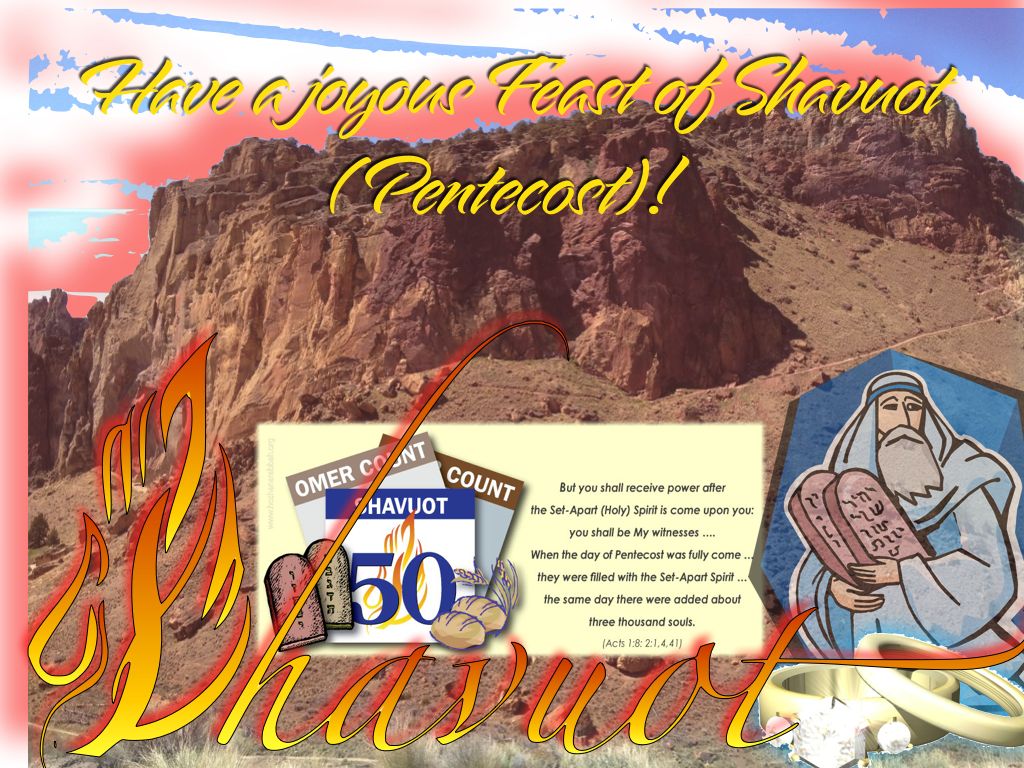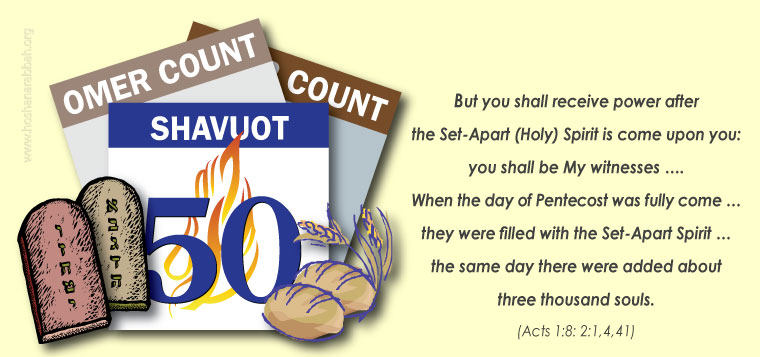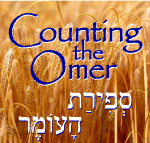Category Archives: Feasts
The Giving of the Torah at Mount Sinai on Pentecost
On Pentecost (Heb. Shavuot), YHVH gave his chosen people the Torah. Also on Shavuot, YHVH “married” Israel (Ezek 16:1–13) when he formulated a covenantal agreement with her to which she agreed when she said “I do” three times (Exod 19:8; 24:1–8). The Torah was the basis of that covenant, or the marriage vows, if you will, to which Israel swore allegiance.
YHVH gave his people the words of life to live by, but because of the hardness of their hearts they were not able to be faithful to his Torah. Like a wife who says “I do” in response to her wedding vows, but cannot remain faithful to her marriage covenant, so Scripture likens Israel to such a woman who became a spiritual harlot (Ezek 16:14–34).
In spite of Israel’s apostasy and spiritual whoredoms, YHVH had made promises to Abraham and to his descendants that were unconditional in nature. Whether Abraham’s descendants remained faithful to YHVH or not, YHVH’s promises to Abraham were inviolate. Though the Israelites had violated the vows they made to YHVH at Mount Sinai, he revealed to the ancient Hebrew prophets that he would eventually formulate a second renewed covenant with Israel, and this time he would pour out upon them his Spirit and write his Torah-laws in their hearts (Jer 31:31–33; 24:7; Ezek 11:19; 36:25–27).
On Passover at the last supper, YHVH-Yeshua betrothed himself to Israel all over again (Matt 26:28; 1 Cor 11:25). As a seal or pledge of this betrothal, he promised to send to his Continue reading
Understanding Pentecost (Pt 2)
Shavuot is the third festival in YHVH’s cyclical parade of annual sacred appointed times. It is also known as the Feast of the Harvest of the First Fruits (Exod 23:16), Day of First Fruits (Num 28:26) and the Feast of Weeks or Shavuot (which is Hebrew for weeks, Exod 34:22; Deut 16:10, 16; 2 Chr 8:13). Shavuot falls fifty days “from the day after the [weekly] Sabbath” (NKJV) that falls during the Days of Unleavened Bread, and hence the derivation of the name Pentecost (meaning “to count fifty”) as recorded in the Testimony of Yeshua (or New Testament/NT, Acts 2:16).
YHVH through his Torah (the law of Moses) instructed his people that Shavuot was…
- a day of rest where laborious or servile work was prohibited (Lev 23:21)
- a commanded assembly (Lev 23:21)
- a time when the priests offered up offerings and sacrifices (Lev 23:18–20)
- a time when all males were to bring the tithes of the increase of their income (Exod 23:14–17; Deut 16:16)
- a time when the priests were to offer up as a wave offering to YHVH two loaves of leavened bread made of the freshly harvested wheat (Lev. 23:17)
- to occur where YHVH would place his name and all were to go there to celebrate it (Deut 16:11)
- a time of rejoicing (Deut 16:11)
- to be forever (Lev 23:21)
An Agricultural Festival With Prophetic Implications
Ancient Israel was an agricultural society that had a spring harvest of grain and a fall harvest of fruit. The spring harvest consisted of the smaller barley harvest, which began during the Days of Unleavened Bread, and the much larger wheat harvest occurring fifty days later at Shavuot. Both the barley and wheat harvests were prophetic pictures symbolizing new life and new creation, and both were presented to YHVH by the priests for his acceptance—a sheaf of barley on First Fruits Day on the Sunday during Hag HaMatzot (the Feast of Unleavened Bread, Lev 23:10–11), and two loaves of leavened wheat bread on Shavuot (Lev 23:17).
On First Fruits Day, the priests of Israel would raise the newly harvested barley and wave it Continue reading
New Video: The Feast of Pentecost Unveiled
Many people have only a vague understanding of Pentecost, even though some churches have incorporated this term into their name. The early church celebrated this biblical feast, so why don’t we?
What are the deeper implications of this biblically commanded assembly?
In this video, learn how Pentecost relate to the grace of Elohim, the former and latter rain, the bride of Yeshua, YHVH’s instructions in righteousness and the second coming of Yeshua.
Understanding Pentecost / The Feast of Weeks
The Feast of Pentecost or Feast of Weeks (Heb. Shavuot) is nearly upon us. This year it will occur on Sunday, May 19. Over the next few days, I will be posting some information on this third of seven biblical feasts of YHVH Elohim.
In the roughly 49 days between Passover (Pesach) and the Feast of Pentecost (Chag Shavuot), a momentous spiritual dynamic occurs. This period of time is comprised of forty-nine days or seven days of seven weeks, which is seven times seven—the biblical number for complete or full perfection. Add one day and you arrive at Pentecost. Fifty is the biblical picture of jubilee picturing redemption from the enslavement to this world.
Historically, the children of Israel were redeemed from their sins by the blood of the lamb on the first Passover in Egypt. At this time, YHVH betrothed himself to Israel (Exod 6:7). YHVH then led them out of Egypt into the wilderness, and on Shavuot he married them at Sinai (Exod 24 cp. Ezek 16:8; Jer 2:2; 31:32). At the same time, YHVH gave them his Torah, which was their ketubah or marriage vows.
Shavuot is a picture of the bride of Yeshua the Messiah coming into full maturity spiritually and coming to marriageable age. She has gone from being a spiritual child and slave in Egypt to becoming the fully mature spiritual bride and queen of the King of the universe.
At the time of Yeshua, he betrothed himself to both houses of Israel on Passover. Then, on Pentecost, he then sent his Spirit, the Comforter, as a seal of this covenant. He hasn’t married this bride (that’s you and me) yet — something that occurs at his second coming. In the mean time, he has placed her in a 2000-years-long wilderness to get ready for him — to fall in love with him (to love him by keeping his Torah commands; John 14:15) by receiving his Torah into their hearts.
In the end times, he’s going to bring his bride (the saints) out of the wilderness of Babylon (called the Second Exodus), and they will repent of their Torahless ways. We are now getting ready for this day.
Understanding the prophecies of the Bible that speak of these end-time events, and understanding who the principal players are (the two houses of Israel) is the key to insure that we’re ready for our Messiah — that we’ll be wise and not foolish virgins who have our lamps full of oil (the Torah and Spirit of Elohim).
Shavuot, along with Passover (Pesach) and the Feast of Tabernacles (Sukkot) are three times each year when YHVH commands his people to gather together to celebrate before him (Exod 23:14–17).
Stay tuned. There’s more to come on this subject!
New Video: The Omer Count & Our Destiny as YHVH’s Bride-Priest
The Israelites’ Passover exodus from Egypt as ex-slaves and their journey to Mt. Sinai where they received the Torah 50 days later and became the Priest-Wife of YHVH prophetically parallels our spiritual journey out of the world to become the bride of YHVH-Yeshua.
This video is like a road map that explains the count of the omer, so you’ll understand where you’ve come from (i.e., bondage in spiritual Egypt), where you’re at (your present life), and what your ultimate spiritual destiny will be (as the bride of YHVH-Yeshua, the soon coming King of kings).
The children of Israel made mistakes that prevented them from entering the Promised Land. You will learn what mistakes not to make, which will keep you from entering the Promised Land of YHVH’s spiritual and eternal kingdom.
Counting the Omer—The Story of Your Life
From the Depths of Slavery to a Kingdom of Priests
Every detail in Scripture is for our learning and edification. All the examples of the past are for our learning upon whom the ends of the world are come (1 Cor 10:11; Rom 15:4). Everyday, YHVH is uncovering the prophetic mysteries hidden in the Scriptures that are being revealed to those who diligently seek him by diligently studying to show themselves approved as a workman rightly dividing YHVH’s Word (2 Tim 2:15).
YHVH’s command for us to count the omer as a countdown to the Feast of Weeks (Heb. Shavuot; Gr. Pentecoste, Lev 23:15–16) memorializes the Israelites’ journey from spiritual babyhood to adulthood. During this 49-day count, Israel ascended from out of the depths of slavery and suffering in Egypt, was baptized in the Red Sea, and then arrived at Mount Sinai—a place of a spiritual standing before YHVH as a kingdom of priests (Exod 19:6). It was there that YHVH gave them his instructions in righteousness—the Torah on Shavuot. This period represents Israel’s passage from slavery to freedom. They came out of slavery permeated with the leaven—the sins, values, and pagan concepts—of Egypt leaving it all behind as pictured by the Feast of Unleavened Bread. YHVH gave Israel 49 days to overcome and to get rid of the impurities of Egypt, and to become the nation Israel—a holy priesthood and the bride of YHVH. There, at the foot of Mount Sinai, YHVH wanted them to become his ambassadors to this world of his heavenly kingdom and truths.
The counting of the omer is the story of our lives also. It pictures our going from bondage to Continue reading





